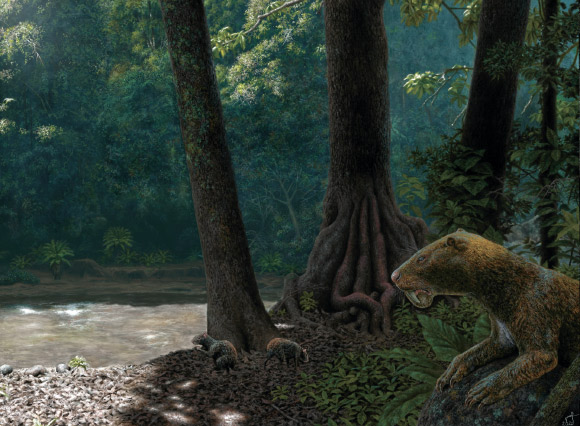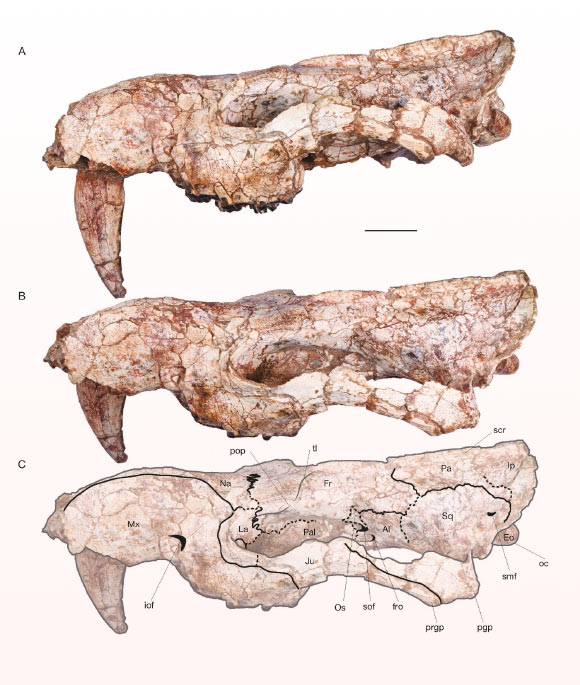The new fossil material belonging to Anachlysictis gracilis, including an almost complete specimen consisting of a nicely preserved skull and postcranial material, reveals new details about the diet and body mass of this enigmatic sparassodont.

Reconstruction of Anachlysictis gracilis stalking some rodents (Neoreomys huilensis) in the La Venta area during Middle Miocene. Image credit: Juan Giraldo.
Anachlysictis gracilis lived in South America during the Miocene epoch, approximately 13 million years ago.
This animal is the most primitive known member of Thylacosmilidae, a family of carnivorous metatherians equipped with ‘saber teeth.’
“The most peculiar feature of this family is their curved and flattened canines, resembling the shape of a saber, so they are commonly known as saber-toothed marsupials,” said Dr. Catalina Suarez, a paleontologist at the Argentine Institute of Nivology, Glaciology and Environmental Sciences.
Anachlysictis gracilis was previously described from the holotype specimen (an almost complete right dentary, fragment of the left, a very fragmentary frontal part of the skull, and a few postcranial elements) and additional jaw fragments.
To these specimens, Dr. Suarez and her colleagues added an almost complete specimen consisting of a nicely preserved skull and postcranial material.
All the fossil specimens of Anachlysictis gracilis are from the Middle Miocene Honda Group in the La Venta area of Colombia.
“Thanks to our discovery, we were able to learn new details about this fascinating species,” Dr. Suarez said.
“The analyses allowed us to understand what these extinct predators were like and how they lived in Neotropical South America millions of years ago.”
“Our research confirms that the Colombian fossil ‘saber-tooth marsupial’ Anachlysictis gracilis is closely related to Thylacosmilus atrox, which is the most widely recognized ‘saber-tooth marsupial’,” said Dr. Javier Luque, a paleontologist at the University of Cambridge Museum of Zoology.
“Both groups, together with Patagosmilus goini (another one of these ‘saber-tooth marsupials’), form their own family in the mammal tree of life, known as Thylacosmilidae.”
“This family is characterized by its long and enormous curved and saber-shaped upper canines, and by an extension of the anterior part of the jaw that looks like the sheath of ‘sabers’.”

Anachlysictis gracilis, left side of the skull: (A) lateral view; (B) dorsolateral view; (C) lineal draw in dorsolateral view. Scale bar – 20 mm. Image credit: Suarez et al., doi: 10.5252/geodiversitas2023v45a18.
“The fossil specimen of Anachlysictis gracilis that we describe in this research constitutes an iconic fossil because of its excellent preservation, three-dimensionality, and importance for understanding the paleobiological aspects of this predatory marsupial that roamed the forests of northern South America approximately 13 million years ago,” said Dr. Edwin Cadena, a paleontologist at the Universidad del Rosario and Smithsonian Tropical Research Institute.
By analyzing the molar teeth, tooth shape and the jaw of the new specimen, the authors were able to reconstruct some paleobiological aspects (diet and body mass) of Anachlysictis gracilis.
Their results revealed that the animal weighed on average about 23 kg (like a lynx) and was a hypercarnivore.
Its potential prey would have included small mammals that inhabited the area, such as marsupials, spiny rats, porcupines, rodents of various sizes and even primates.
“We now plan to address all the other bones in the body of Anachlysictis gracilis, which include various sections of the spine, ribs, hip, scapulae — what we call ‘shoulder blades’ for humans — and bones in its legs,” Dr. Suarez said.
“This will allow us to explore aspects of how it moved, the position in which its neck held its head, whether it was a runner, whether it could climb, whether its hands could hold objects more easily, as many marsupials do when feeding, or whether it was a bit more difficult, as it is for example for a dog or a cat.”
The findings were published in the journal Geodiversitas.
_____
C. Suarez et al. 2023. A sabre-tooth predator from the Neotropics: Cranial morphology of Anachlysictis gracilis Goin, 1997 (Metatheria, Thylacosmilidae), based on new specimens from La Venta (Middle Miocene, Colombia), in J.D. Carrillo (ed.), Neotropical palaeontology: the Miocene La Venta biome. Geodiversitas 45 (18): 497-572; doi: 10.5252/geodiversitas2023v45a18







